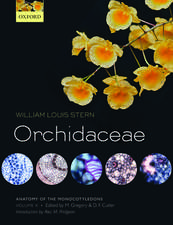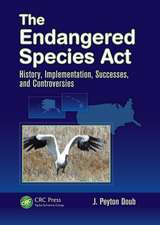Algal Culturing Techniques
Editat de Robert A. Andersenen Limba Engleză Hardback – 3 mar 2005
Algal Culturing Techniques was developed to serve as both a new textbook and key reference for phycologists and others studying aquatic systems, aquaculture and environmental sciences. Students of algal ecology, marine botany, marine phycology, and microbial ecology will enjoy the hands-on methodology for culturing a variety of algae from fresh and marine waters. Researchers in industry, such as aquaculture, pharmaceutical, foodstuffs, and biotechnology companies will find an authoritative and comprehensive reference.
- Sponsored by the Phycological Society of America
- Features color photographs and illustrations throughout
- Describes culturing methods ranging from the test tube to outdoor ponds and coastal seaweed farms
- Details isolation techniques ranging from traditional micropipette to automated flow cytometeric methods
- Includes purification, growth, maintenance, and cryopreservation techniques
- Highlights methods for estimating algal populations, growth rates, isolating and measuring algal pigments, and detecting and culturing algal viruses
- Features a comprehensive appendix of nearly 50 algal culture medium recipes
- Includes a glossary of phycological terms
Preț: 588.18 lei
Preț vechi: 717.29 lei
-18% Nou
Puncte Express: 882
Preț estimativ în valută:
112.55€ • 117.82$ • 93.13£
112.55€ • 117.82$ • 93.13£
Carte disponibilă
Livrare economică 15-29 martie
Livrare express 01-07 martie pentru 92.89 lei
Preluare comenzi: 021 569.72.76
Specificații
ISBN-13: 9780120884261
ISBN-10: 0120884267
Pagini: 592
Ilustrații: illustrations
Dimensiuni: 216 x 276 x 33 mm
Greutate: 2.18 kg
Editura: Elsevier
ISBN-10: 0120884267
Pagini: 592
Ilustrații: illustrations
Dimensiuni: 216 x 276 x 33 mm
Greutate: 2.18 kg
Editura: Elsevier
Public țintă
This reference will be used by nearly everyone who grows algal cultures, including scientists and students involved with phycological research. Libraries. Aquaculturists, biotechnologists, governmental scientists, etc., will treasure it.Cuprins
1. Historical Review of Algal Culturing Techniques
2. Freshwater Culture Media
3. Marine Culture Media
4. Trace Metal Ion Buffers and Their Use in Culture Studies
5. Sterilization and Sterile Technique
6. Traditional Microalgae Isolation Techniques
7. Automated Isolation Techniques for Microalgae
8. Purification Methods for Microalgae
9. Isolation and Purification Techniques for Macroalgae
10. Perpetual Maintenance of Actively Metabolizing Microalgal Cultures
11. Long Term Macroalgal Culture Maintenance
12. Cryopreservation Methods for Maintaining Microalgal Cultures
13. Photobioreactors and Fermentors: The Light and Dark Sides of Growing Algae
14. Culturing Microalgae in Outdoor Ponds
15. Mariculture of Seaweeds
16. Counting Cells in Culture Using the Light Microscope
17. Phytoplankton Cell Counting by Flow Cytometry
18. Measuring Growth Rates in Microalgal Cultures
19. Using Cultures to Investigate the Physiological Ecology of Microalgae
20. Analysis of Algal Pigments by High-Performance Liquid Chromatography
21. Endogenous Rhythms and Daylength Effects in Macroalgal Development
22. Viral Contamination of Algal Cultures
23. Control of Sexual Reproduction in Algae in Culture
24. Microalgal Life Cycle Dynamics: Encystment and Excystment
25. Cultures as a Means of Protecting Biological Resources: Ex-situ Conservation of Threatened Algal Species
2. Freshwater Culture Media
3. Marine Culture Media
4. Trace Metal Ion Buffers and Their Use in Culture Studies
5. Sterilization and Sterile Technique
6. Traditional Microalgae Isolation Techniques
7. Automated Isolation Techniques for Microalgae
8. Purification Methods for Microalgae
9. Isolation and Purification Techniques for Macroalgae
10. Perpetual Maintenance of Actively Metabolizing Microalgal Cultures
11. Long Term Macroalgal Culture Maintenance
12. Cryopreservation Methods for Maintaining Microalgal Cultures
13. Photobioreactors and Fermentors: The Light and Dark Sides of Growing Algae
14. Culturing Microalgae in Outdoor Ponds
15. Mariculture of Seaweeds
16. Counting Cells in Culture Using the Light Microscope
17. Phytoplankton Cell Counting by Flow Cytometry
18. Measuring Growth Rates in Microalgal Cultures
19. Using Cultures to Investigate the Physiological Ecology of Microalgae
20. Analysis of Algal Pigments by High-Performance Liquid Chromatography
21. Endogenous Rhythms and Daylength Effects in Macroalgal Development
22. Viral Contamination of Algal Cultures
23. Control of Sexual Reproduction in Algae in Culture
24. Microalgal Life Cycle Dynamics: Encystment and Excystment
25. Cultures as a Means of Protecting Biological Resources: Ex-situ Conservation of Threatened Algal Species
Recenzii
"It has been worth the wait. Andersen and the authors have done a tremendous job bringing together many old and new methods in highly readable and easy to follow order...In addition to the older standard methods, it adds many new ones, from automated isolation and counting of algal cells to use of cultures as a way to prevent extinctions of threatened species...the methods chapters, e.g., Andersen and Kawachi on microalgal isolation techniques are very detailed, providing plain, easy to follow, often step-by-step instructions, complete with supplies needed and even sources, on how to do particular tasks...Bob Andersen, the authors, and PSA are to be commended for bringing together so much detailed information in one place. The book is beautifully produced...It definitely needs to be in the lab and/or office of everyone doing research on algae...I highly recommend it." --R.A. Horner, University of Washington, School of Oceanography, Seattle, U.S.A., in HARMFUL ALGAE (2006)
"This comprehensive book is a necessity for research scientists who use and maintain algal cultures." --CHOICE (October 2005)
"This comprehensive book is a necessity for research scientists who use and maintain algal cultures." --CHOICE (October 2005)







